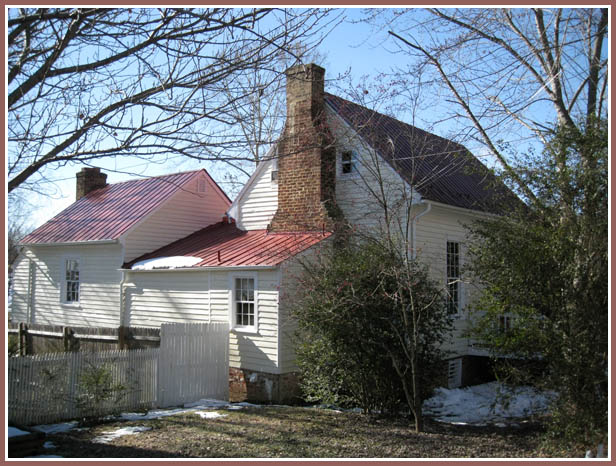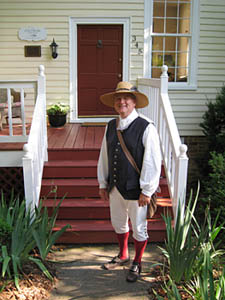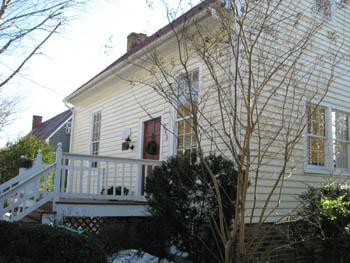

  |
|

|
Name: The Colonial House Date: March 2010 Image Number: CG82cdCG08 Comments: Located at 345 East Main Street, the Colonial House (also known as the Fore House) is possibly the oldest remaining building in Scottsville. The back wing of the house was built ca. 1732, and the front part of the house was built in 1780. In 2010, this house still has its original beaded siding with rose-headed nails. The Colonial House is one of 53 historic buildings in Scottsville's 1976 historic district listing on the National Registry of Historic Places. In 1841, the Albemarle County land records indicate that this Scottsville property, lot #21, was owned by Samuel W. Tompkins. At that time, only one lot physically separated this house from the James River. In 2010, the grass-covered levee and the railroad tracks physically separate this house from the river. Originally a hall-and-parlor-style dwelling and linear in plan, the house has a one-story shed-roof addition on the east facade and a one-and-a-half story rear addition to create an L-shaped form. Pictured below is the front of the Colonial House as this June 2009 Batteau Festival participant in colonial attire stopped by for a visit. This reenactor had stopped his batteau for the night down on the nearby James River bank and walked into town, looking for food and drink. This modern day strategy was probably quite similar to the thinking of 18th century batteau men after a long, hot day on the James as observed by early residents of this house.   To learn more about the history of the Colonial House at 345 East Main Street, please read the following article by Ruth Klippstein that appeared in the May 2014 edition of the Scottsville Monthly: The Tangled History of 345 East Main Street by Ruth Klippstein The Colonial House The Scottsville location we now designate as 345 East Main Street was once forested lowland with a view of the outside curve of the James River. Known to beavers perhaps, racoons certainly, and maybe bobcats, it was land hunted and used by the Monacans. When Europeans arrived, looking for places to settle that had water and access to trade, it became real estate, a house, a history. It became 345 East Main Street. It might have seemed a tangle to the new wave of settlers, though it must have offered wild fruits, fish to catch, and ample water to use. A main street for the new settlement was laid out, building lots were drawn, the ferry began to run. Nearby houses were built here in the county seat of Albemarle, more than 100 years before the canal and the old tavern across the street. The small house, now called Colonial House and known also as the Fore House (named for an early 1950's resident, house-painter Jim Fore, according to Gene Harding) was documented in the autumn of 1936 by R.E. Hannum of Union Mills, who wrote descriptions of several Scottsville and Southern Albemarle places for the WPA's Historic Virginia Inventory. These priceless records, often including maps and photographs of now-demolished buildings that were part of Virginia's everyday life, are readable online through the University of Virginia Library. Hannum labels the house simply "Dwelling adjoining Pitts' mansion." Up until the 1950's, the house was next door to a most imposing two-story brick structure, sensibly built on a basement with 18-inch thick walls, originally with an unroofed porch on the rear, later a roofed porch across the front as well, and entered by "heavy double doors." A date left on a corner gutter gives the house's construction as 1831. Miss Mary Agnes Pitts, its owner in 1936, told Hannum the cottage to the east was "traditionally thought to be as old as the Pitts' home," and Hannum assumed it was "probably a little older." The Pitts mansion, now demolished, was located at what now is the site of the East Main Garage. Hannum describes the house as "an L-shaped, story-and-a-half frame building with a three-roomed basement" from prior to 1731. Ed Lay also says in his notes that the hall-parlour, or part of the house facing East Main Street, was built prior to 1831, and the "L" addition was built ten or fifteen years later. This same information is used to describe the house in Scottsville's 1976 application to the U.S. Department of the Interior for inclusion in the National Register of Historic Places. An undergraduate student of Professor Lay, Marsha Glen wrote in her 1976 project, 'Architectural Survey of Scottsville,' that the two buildings were connected "early in the nineteenth century." There is a third element, namely the north of the rear wing east of the original house which was added on with a shed roof. This leaves us now with several conflicting possibilities for the Colonial House dates. Hannum does not suggest there was anything but one L-shaped house, built before the 1831 Pitts house next door. Professor Lay's UVA papers say the two parts of the "L" are separate constructions ten or fifteen years apart. Jean Cooper's 2007 Guide to Historic Charlottesville and Southern Albemarle County and Susan deAlba's 1993 Country Roads, Albemarle, Virginia date the front section, facing East Main Street, as being from 1780, and the rear wing, which would have had a door to the west and be well set back from the street, as being from 1732. Professor Lay's 2000 Architecture of Jefferson Country says they were "perhaps built around 1780..." The Scottsville Museum states that the rear section was the original house and the front was the newer wing, whereas the National Register description says 1732 for the front and "about 15 years" later for the rear, or circa 1747. Ah, the mysteries of Scottsville. Besides Samuel Tompkins, this house has been owned by Mrs. Pete Hamner, who sold it to D.H. Pitts in 1870. Pitts willed it to his sisters of whom Mary Agnes Pitts, Hannum's informant, was one. In the 1970's and into the 1990's, Frances Joseph, who also owned the Canal Warehouse, held the deed to the Colonial House. Lewis Ramsey, a house collector and restorer, who had lived in Slate River, Buckingham County, bought the house in the 1990's from his sister Frances for "much less than it was worth," as John Snoddy remembers him saying, because the person living there was sure there was a ghost. There was, in fact, John says, a drunk who regularly crept under the house at night and rummaged through his empties, making, apparently, ghostly noises. Lewis did the bulk of the renovation on the Colonial House, finding the entire basement floor covered in many feet of silt and virtually abandoned. Luke Ramsey, Lewis Ramsey's son who currently heads Ramsey Restoration in Wingina, says he and his father lived in the Colonial House after Lewis purchased it. "It was hardly livable when we moved in," Luke recalls. "It didn't really have a basement because that was filled with silt." Lewis laboriously dug it out and restored the kitchen; Luke remembers sleeping there because the rest of the house was so cold. After much effort, inside and on the landscaping, Lewis restored the house to its simple elegance. Stuart, who works in Richmond and is a docent at the Scottsville Museum, is clear that the odd spaces of his home show it was two separate houses, but he has not yet uncovered much more information. He's hunted deeds but wishes for "the good part," the stories about the house and the people who lived there. He hopes to help develop such house histories with Dan Gritsko and the tourism committee to promote Scottsville as the summer season begins. Stuart has done little to change the house, though he adds his own touch -- and old ship models. He worked closely with the Scottsville Architectural Review Board to create a needed garage, between the house and the levee, that mirrors the house's architecture. He's also had to have the front door taken apart, due to water leakage, and rebuilt with new elements; he's added a storm door and fixed the gutter to keep the problems from recurring. John Snoddy dealt with the water problem, too. He had various gutters re-piped to take water away from the foundation, sending it under the yard to the storm drain. "The kitchen floor was damp brick when I moved in," John writes in an email, "and we removed that surface and about two feet of substandard soil underneath it. Drainpipes were installed to pipe a spring which had given access to indoor, fresh water (as evidenced by drain pipes found under the stairs during the 2005 excavation) through the southwestern kitchen wall, under the yard, and out to the storm drain." Water is still a problem, and it's only due to the A. Raymon Thacker Levee that the last real estate ad in 2012 could confidently declare the place was "a stone's throw from the James River." This fine place, once a wooded river bank, then developed as Scottsville grew, now recognized and preserved, lives on into the 21 st century. As it's changed, Stuart Munson says, "many of the original aspects -- the banister railings, floorboards, and narrow stairs -- have been saved," though he has ample room for his computer and microwave. The National Register of Historic Places includes structures for their "age, integrity, and significance" and helps owners consider strategies for renovation and repair. We all benefit. The WPA project's final line that Hannum had to fill in, number 28, asks, "Does occupant seem to appreciate old architectural features?" "Yes," was the answer. The top three photos are from the Connie Geary Collection at Scottsville Museum. The last five photos are from the th Klippstein Collection at
Scottsville Museum. Top Image Located On: Capturing Our Heritage, CD CG08 CG82cdCG08.tif CG82cdCG08.jpg CG82cdCG08.psd Second Image (Left) Located On: Capturing Our Heritage, CD CG07 CG2198cdcg07.tif CG2198cdcg07.jpg CG2198cdcg07.psd Third Image (Right) Located On: Capturing Our Heritage, CD CG08 CG81cdCG08.tif CG81cdCG08.jpg CG81cdCG08.psd Fourth Image Located On: Capturing Our Heritage, CD RK02 RK03cdRK02.tif RK03cdRK02.jpg RK03cdRK02.psd Fifth Image Located On: Capturing Our Heritage, CD RK02 RK04cdRK02.tif RK04cdRK02.jpg RK04cdRK02.psd Sixth Image Located On: Capturing Our Heritage, CD RK02 RK05cdRK02.tif RK05cdRK02.jpg RK05cdRK02.psd Seventh Image Located On: Capturing Our Heritage, CD RK02 RK06cdRK02.tif RK06cdRK02.jpg RK06cdRK02.psd Eighth Image Located On: Capturing Our Heritage, CD RK02 RK07cdRK02.tif RK07cdRK02.jpg RK07cdRK02.psd |
|
|
|
Museum
Archive
Business
Cemeteries
Church
Events
Floods
For Kids
Homes
Portraits
Postcards
School
Transportation
Civil War WWII Search Policy |
||||
|
Scottsville Museum · 290 Main Street · Scottsville, Virginia 24590 · 434-286-2247 www.avenue.org/smuseum · info@scottsvillemuseum.com Copyright © 2018 by Scottsville Museum |
||||